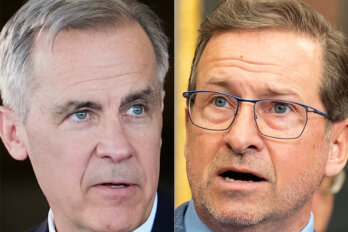So far, Jason Kenney and his United Conservative Party have picked fights with environmentalists, journalists, and academics in an ongoing campaign to defend Alberta’s beleaguered oil-and-gas industry. According to the premier, “foreign-funded special interests” have been waging an “anti-Alberta campaign,” one he’s made a lot of noise about stopping with, among other things, a $2.5 million public inquiry. The volume of that noise was ratcheted up last month with the official launch of the Canadian Energy Centre, a pro-oil-and-gas communications outlet. The so-called war room is staffed by researchers and former Postmedia personnel and endowed with a budget of $30 million—and the premier’s personal seal of approval.
Listen to an audio version of this story
For more audio from The Walrus, subscribe to AMI-audio podcasts on iTunes.
But, while these efforts have made some Albertans understandably nervous, it’s Kenney’s apparent willingness to spar with major ratings agencies, insurance companies, and other instruments of global capital that should have everyone in the province—including conservatives—worried. Early last December, after credit-analysis corporation Moody’s downgraded Alberta’s debt rating due to the impact of volatile oil markets on the province’s finances, Kenney lashed out at the New York–based firm, suggesting it was “buying into the political agenda emanating from Europe.” He also took a swipe at European insurance companies, suggesting that their decision to stop offering coverage to Alberta’s oil sands operators is due to “distorted, torqued data provided by green left pressure groups.”
These comments misunderstand the meaningful shift now underway in how the financial community views and prices the risks associated with climate change. This isn’t because it has fallen under the sway of Greta Thunberg as some in Alberta seem to believe, or because it has succumbed to a European political agenda, as the premier himself is suggesting. It’s because central banks, insurance companies, and investment firms are all increasingly aware that global action on climate change will reduce the value of billions of dollars of fossil fuel assets like coal deposits and oil-and-gas reserves, and they’re working to ensure they’re not exposed to those losses. “There will be industries, sectors, and firms that do very well during this process because they will be part of the solution,” said Mark Carney, the former Goldman Sachs banker from Alberta who served as governor of both the Bank of Canada and the Bank of England, in an interview with the Guardian. “But there will also be ones that lag behind, and they will be punished.”
That punishment will likely take the form of reduced access to capital, less generous valuations on the stock market for their shares, and according to Carney, outright bankruptcy for those who are at the back of the pack. Carney, who recently took on a new job as the United Nations’ special envoy on climate action and finance, is hardly alone in making these sorts of predictions. Michael Sabia, the outgoing president and CEO of the Caisse de dépôt et placement du Québec (CDPQ), which managed $326 billion in net assets as of June 30, 2019, believes that low-carbon investing is about creating value, not virtue. That’s why the CDPQ, which, according to Bloomberg, had 16.4 percent of its assets in carbon-intensive sectors like energy and materials (including major stakes in companies like Enbridge, Cenovus, and Suncor) at the end of 2016, pledged in 2017 to increase its investment in low-carbon assets like renewable energy, battery technologies, and public transportation by 50 percent by 2020—and subsequently increased that target to 80 percent. “It comes from our strong belief about the upside potential in investment in measures to address climate change,” he told Corporate Knights. “Because this is not going away. This is not some passing fad; this is going to be with us for ten, twenty, thirty years and more.”
“After a decade of energy stocks massively underperforming, money managers on Bay and Wall Streets have had enough.”
That appears to be the opinion of Sweden’s central bank, which sold off its holdings of government bonds issued by Alberta, Queensland, and Western Australia on the basis of their elevated exposure to climate risk. It was certainly the opinion of Moody’s when it downgraded the province’s credit rating on the basis of its overreliance on oil-and-gas revenue and the growing economic risks associated with climate change. “In Moody’s assessment, environmental considerations are material to Alberta’s credit profile and Moody’s considers environmental risk to be high,” its December report stated. Even Goldman Sachs, which isn’t exactly known for putting principle ahead of profits, has pledged to invest $750 billion (US) over the next decade in “sustainable finance” projects. It has also decided to stop investing in any new oil-and-gas production and exploration projects in the Arctic. And last week BlackRock, the largest fund manager in the world, officially signed on to the Climate Action 100+ campaign, which, since launching in 2017, has been pushing the biggest corporate greenhouse gas emitters to curb emissions and improve climate-related financial disclosures. All told, the 370-plus members manage a combined USD $35 trillion.
Then there’s California, which now has a law on the books requiring the state’s two largest pension funds—which together control over $600 billion (US) in assets—to factor climate risk into their investment decisions. And, as if to add insult to injury, Norway’s trillion-dollar sovereign wealth fund—the one that was created from the country’s oil-and-gas revenue—announced last year that it was planning to sell $7.5 billion (US) of energy shares, including twenty-six Canadian companies. Last October, it was joined by the largest pension fund in Norway, the Kommunal Landspensjonskasse, which removed four Canadian oil-and-gas companies from its portfolio and announced it wouldn’t invest in those that got more than 5 percent of their revenue from the oil sands.
Maybe most damaging for Kenney and his war room is that some oil-and-gas companies, members of the very sector he is allegedly fighting on behalf of, are trying to get ahead of this trend. Shell, for example, announced that the interest and fees on the $10 billion (US) that it can borrow from its syndicate of twenty-five banks will be directly informed by its progress on climate measures. In other words, the better it does at reducing its emissions, the less it will have to pay in interest—a precedent that will almost certainly be looked to by other banks looking to reduce their own exposure to climate risk. And Canadian oil sands companies like Suncor, CNRL, and Cenovus continue to press their case as responsible energy companies by reducing per-barrel emissions. Cenovus, for example, just announced that it’s aiming for net-zero greenhouse gas emissions from its oil production by 2050, and its CEO Alex Pourbaix suggested that the target will “position us to thrive in the transition to a lower-carbon future.”
These companies clearly understand that their long-term viability is mediated by the golden rule, which is that the people with the gold make the rules. And the rules being made by major banks and pension funds when it comes to fossil fuels and climate change are increasingly clear: carbon emissions can’t continue to grow the way they have, and we intend to invest accordingly.
As if that weren’t enough for Alberta to deal with, there’s also a growing campaign to force CEOs of oil-and-gas companies to start paying attention to profits instead of production. For the better part of a decade now, the industry has outspent the cash flow it generates from its operations—this at a time when oil prices were frequently above $100 (US) per barrel. How much cash? According to a June 2019 Sightline Institute report, a sample of twenty-nine US shale companies burned through a combined $184 billion (US) between 2010 and 2019. They did that to grow their production, and they funded the shortfall between the cash they spent and the cash they generated by issuing billions of dollars of debt and equity each year—which means that much of the industry was being subsidized by its investors. But now, after a decade of energy stocks massively underperforming, money managers on Bay and Wall Streets have had enough.
In a March 2019 letter to the CEOs of thirteen mid-size Canadian oil-and-gas companies, Eric Nuttall—a portfolio manager at Ninepoint Partners and one of the most vocal champions of the energy sectors—stressed the need to stop focusing on growing production, implying that their jobs might ultimately be in jeopardy. “The market clearly does not care about growth,” he wrote, while admitting that the market could be fickle. Still, if this push to slow the creation of additional wells is successful, it will mean even less activity in Alberta’s oil fields—and, all other things being equal, less royalty revenue for its government.
None of this is good news for Kenney or his efforts to make Alberta’s energy sector great again. His $30 million war room might be able to intimidate local critics, but it will have no impact on the people making investment decisions in London, Toronto, and New York—or the billions of dollars they control. Those fund managers are driven by the need to balance their returns against their risks, and right now, investments in fossil fuels don’t look as attractive as they used to. The best way for Kenney to reduce risk would be by investing in technology that can reduce the greenhouse gas emissions created by Alberta’s oil-and-gas industry, not attacking the people who draw attention to these emissions. Taking the war room’s annual budget and giving it to Emissions Reduction Alberta, an organization that’s been investing in lower-carbon technologies since 2009, would be a good place to start.
That’s unlikely to happen, though. Rather than addressing the concerns of global investors, Kenney’s government continues to press forward with its strategy of talking up the energy sector’s merits—and attacking anyone (including a reporter at a Medicine Hat newspaper) who dares challenge them. Its war room has been a rolling fiasco. When it hasn’t been caught trading in falsehoods (a recent response to a Globe and Mail editorial had it claiming, against all evidence, that the carbon footprint of Canada’s oil production is “steadily decreasing”), it’s provided plenty of comedic relief. For example, it launched with a logo that belonged to US tech company, then replaced it with a new logo highly derivative of another US tech company.
But there’s nothing funny about the real damage the war room is doing to Alberta’s ability to understand where the real challenges are coming from. Yes, its PR team can continue to send sternly worded letters to local newspapers and make inflated claims about Alberta’s oil-and-gas industry, but that won’t help the province address the real concerns raised by the financial industry—concerns that will have a meaningful impact on the energy sector’s ability to raise capital and fund operations in the future. Raging against this reality will only serve to underscore its durability—and remind investors that Alberta seems more intent on rebuilding the past than preparing for the future.
January 17, 2020: This story has been updated to reflect additional reporting on international fund manager BlackRock and Canadian oil company Cenovus.




